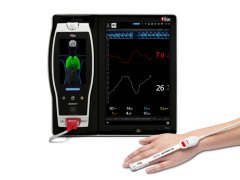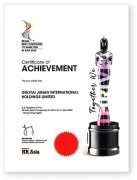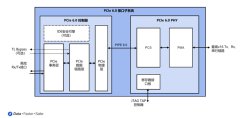Strong underlying performance
Orders $6.1 billion, -9%; comparable -8%1
Revenues $6.6 billion, -4%; comparable -4%
Income from operations $71 million; margin 1.1%
Power Grids gain of $5.3 billion, pre-tax, recorded in discontinued operations
Operational EBITA1 $787 million; margin1 12.0%
Net income $4.5 billion, +780%, including Power Grids gain
Basic EPS $2.14, +785%2; operational EPS1 $0.21, -36%
Cash flow from operating activities $408 million, after $273 million negative impact from pensions; resilient cash delivery expected for the full year
ZURICH -- (BUSINESS WIRE) --
“Third quarter revenues in all business areas were still dampened due to the impact of COVID-19, although a strong recovery in China and ongoing cost mitigation efforts supported a strong underlying performance. On the upside, the integration of GEIS and turnaround of Installation Products in Electrification is starting to bear fruit and Motion is performing robustly. Robotics and Industrial Automation, on the other hand, are taking more time to recover,” said Björn Rosengren, CEO of ABB. “We are pushing ahead with the decentralization of the group and the ongoing review of our portfolio, while carrying out our share buyback program as planned. We look forward to presenting further details on our strategic progress at our Capital Markets Day on November 19.”
|
KEY FIGURES |
|
|
CHANGE |
|
|
CHANGE |
|||
|
($ millions, unless otherwise indicated) |
Q3 2020 |
Q3 2019 |
US$ |
Comparable |
9M 2020 |
9M 2019 |
US$ |
Comparable |
|
|
Orders |
6,109 |
6,688 |
-9% |
-8% |
19,509 |
21,702 |
-10% |
-7% |
|
|
Revenues |
6,582 |
6,892 |
-4% |
-4% |
18,952 |
20,910 |
-9% |
-7% |
|
|
Income from operations |
71 |
577 |
-88% |
|
1,015 |
1,290 |
-21% |
|
|
|
Operational EBITA1 |
787 |
806 |
-2% |
-5%3 |
2,074 |
2,397 |
-13% |
-14%3 |
|
|
as % of operational revenues |
12.0 |
11.7 |
+0.3 pts |
|
10.9 |
11.5 |
-0.6 pts |
|
|
|
Net income attributable to ABB |
4,530 |
515 |
+780% |
|
5,225 |
1,114 |
+369% |
|
|
|
Basic EPS ($) |
2.14 |
0.24 |
+785%2 |
|
2.45 |
0.52 |
+370%2 |
|
|
|
Operational EPS ($)1 |
0.21 |
0.33 |
-36%2 |
-35%2 |
0.73 |
0.97 |
-25%2 |
-24%2 |
|
|
Cash flow from operating activities4 |
408 |
670 |
-39% |
511 |
414 |
+23% |
|||
Q3 2020 Group results
Summary
Trading conditions during the third quarter remained challenging, influenced by the ongoing COVID-19 pandemic. Demand decreased year-on-year in all regions despite a strong rebound in China, which drove improved order development, particularly in Robotics. Short-cycle product businesses developed positively, but this was outweighed by lower large orders and the ongoing pull-back of service activities. Operating margins for the group were weighed by non-core charges and a loss in Industrial Automation in relation to the Kusile project in South Africa. Excluding these effects, margins showed good underlying resilience, reflecting sustained cost mitigation in all business areas, and strong progress in Electrification with the integration of GEIS and turnaround of Installation Products. Motion maintained its track record of solid performance.
Orders
Orders were 9 percent lower (8 percent comparable) in the quarter compared to the prior year period. Foreign exchange translation effects had a neutral impact and portfolio changes a net negative impact of 1 percent. The order backlog was $13,878 million at the end of the quarter.
Regional overview
– Orders from Europe were 9 percent lower (10 percent comparable) with mixed results at the country level. Sweden, Norway and the Netherlands showed solid growth, while orders declined in most other countries including Switzerland, the UK, Italy and Spain, when compared to the prior year period. In Germany, orders were 11 percent lower (14 percent comparable).
– Orders from the Americas were 14 percent lower (11 percent comparable), with most countries reporting lower order levels. In the US, orders declined by 13 percent (12 percent comparable).
– In Asia, Middle East and Africa (AMEA), orders were 1 percent lower (2 percent comparable). Orders were materially lower in India, Japan and Singapore, while order developments in South Korea were robust. China’s growth was strong, with orders up 7 percent (8 percent comparable).
End-market overview
– In discrete industries, orders were mixed. While the group benefited particularly from select order wins in the automotive and 3C sectors, demand from machine builders was weak. Some end-markets, such as food & beverage and logistics, grew strongly.
– Process and energy industry activities were materially lower in the quarter. Service activities were still constrained by travel restrictions, as well as customers delaying service spend. Capital expenditure projects continue to be deferred as most customers adjust to the weaker demand outlook.
– In transport & infrastructure, investments in rail, e-mobility, wind and data centers were healthy. Furthermore, orders were resilient in electrical distribution utilities. Marine activities declined steeply.
– Buildings were mixed, depending on geography.
Revenues
Revenues were 4 percent lower (4 percent comparable) year-on-year reflecting weakness across all four business areas. Foreign exchange translation effects had a net positive impact of 1 percent and portfolio changes a net negative impact of 1 percent. The book-to-bill ratio for the quarter was 0.93x1, compared to 0.97x in the prior year period.
Income from operations and operational EBITA
Income from operations was $71 million. The result for the quarter includes approximately $311 million goodwill impairment and $203 million of charges due to changes in obligations related to divested businesses.
In addition, the result reflects regular non-operational items including amounts related to timing differences on commodities and foreign exchange and expenses related to restructuring and integration efforts.
Operational EBITA1 was 2 percent lower (5 percent in local currencies), at $787 million. The operational EBITA1 margin of 12.0 percent expanded 30 basis points year-on-year. Margins were higher in Electrification, while all other businesses reported lower margins on a year-on-year basis, mainly reflecting lower volumes. Corporate and Other improved by $24 million compared to a year ago, due to the removal of stranded costs and lower ongoing corporate costs, partially offset by higher charges for non-core business activities.
The 12.0 percent operational EBITA margin includes a negative 80 basis points impact from the proposed settlement in South Africa with Eskom in relation to the Kusile project which resulted in a further project revaluation and, in addition, a negative 130 basis points impact from the aforementioned charges for non-core business activities.
Net income and basic earnings per share
Group net income attributable to ABB was $4,530 million. Net income benefited from the net income from discontinued operations of $5.0 billion, which included a $5.3 billion pre-tax book gain on the sale of Power Grids and income tax expenses related to the divestment. ABB also recorded non-operational pension costs of $343 million. Further details on this item follow below. Income tax expense was $164 million in continuing operations.
Basic EPS of $2.14 was up 785 percent on a year-on-year basis. Operational EPS of $0.211, down 36 percent2 compared to the prior year period.
Cash flow from operating activities
Cash flow from operating activities was $408 million including a $273 million negative impact from a cash outflow to facilitate the transfer of certain pension schemes, compared to $670 million in the third quarter of 2019. Cash flow benefited from favorable timing of tax payments and net working capital movements, which offset the effects of a reduction in business activities. As a percent of revenues, net working capital was 12.5 percent at quarter end.
Q3 2020 business area results
All commentary by business area relates to third quarter results on a year-on-year basis.
Electrification (EL)
|
KEY FIGURES |
|
|
CHANGE |
|
|
CHANGE |
|||
|
($ millions, unless otherwise indicated) |
Q3 2020 |
Q3 2019 |
US$ |
Comparable |
9M 2020 |
9M 2019 |
US$ |
Comparable |
|
|
Orders |
2,952 |
3,188 |
-7% |
-5% |
8,810 |
9,890 |
-11% |
-7% |
|
|
Order backlog |
4,471 |
4,537 |
-1% |
+2% |
4,471 |
4,537 |
-1% |
+2% |
|
|
Revenues |
3,031 |
3,161 |
-4% |
-2% |
8,568 |
9,490 |
-10% |
-6% |
|
|
Operational EBITA1 |
493 |
450 |
+10% |
|
1,159 |
1,267 |
-9% |
|
|
|
as % of operational revenues |
16.3% |
14.2% |
+2.1 pts |
13.5% |
13.3% |
+0.2 pts |
|
||
|
– |
Short-cycle activities showed good resilience overall with healthy momentum in distribution utilities, data centers, food and beverage, wind, rail and e-mobility, offset by fewer large orders and weaker long-cycle demand. Buildings were mixed, depending on geography, and oil and gas activities declined materially. Demand from the Americas and AMEA showed continued COVID-19 impacts, offsetting the strong recovery in China. |
|
|
– |
Resilient short-cycle business revenues were dampened by a more challenged project business, mainly in the US. |
|
|
– |
Margin accretion of 210 basis points reflects solid operational performance. The third quarter result includes benefits of approximately 100 basis points from items that may not repeat. Good cost mitigation and supportive pricing actions helped offset the impact of lower volumes. The exit of the solar inverter business and improved performance from Installation Products and GEIS also supported margins. |
Industrial Automation (IA)
|
KEY FIGURES |
|
|
CHANGE |
|
|
CHANGE |
|||
|
($ millions, unless otherwise indicated) |
Q3 2020 |
Q3 2019 |
US$ |
Comparable |
9M 2020 |
9M 2019 |
US$ |
Comparable |
|
|
Orders |
1,164 |
1,438 |
-19% |
-20% |
4,226 |
4,726 |
-11% |
-9% |
|
|
Order backlog |
5,152 |
4,944 |
+4% |
+2% |
5,152 |
4,944 |
+4% |
+2% |
|
|
Revenues |
1,403 |
1,492 |
-6% |
-7% |
4,247 |
4,590 |
-7% |
-6% |
|
|
Operational EBITA1 |
89 |
135 |
-34% |
|
348 |
530 |
-34% |
|
|
|
as % of operational revenues |
6.4% |
9.0% |
-2.6 pts |
8.2% |
11.5% |
-3.3 pts |
|
||
|
– |
Industrial Automation results were impacted by the proposed settlement in South Africa with Eskom in relation to the Kusile project which resulted in a further project revaluation. This lowered both orders and revenues by 3 percent and operational EBITA margin by 400 basis points. A revaluation of the same project had a similar margin impact in the same period a year ago. |
|
|
– |
Orders were otherwise materially impacted by the ongoing downturn in energy and marine, although the business area benefited from select large order wins and resilience in process industries, including Pulp & Paper. Orders were lower in all regions, with a severe drop in the Americas. Subsequent to the quarter, the business area secured a marine order in excess of $300 million. |
|
|
– |
Revenue weakness reflects a substantial drop in book-and-bill activities, particularly mobility constrained services. |
|
|
– |
Aside from the project impact in South Africa, margins improved sequentially as the business worked to fast-track cost savings, but remained impacted by lower volumes and unfavorable mix, with service activities still hampered by COVID-19 restrictions. |
Motion (MO)
|
KEY FIGURES |
|
|
CHANGE |
|
|
CHANGE |
|||
|
($ millions, unless otherwise indicated) |
Q3 2020 |
Q3 2019 |
US$ |
Comparable |
9M 2020 |
9M 2019 |
US$ |
Comparable |
|
|
Orders |
1,535 |
1,618 |
-5% |
-5% |
5,022 |
5,180 |
-3% |
-1% |
|
|
Order backlog |
3,349 |
2,947 |
+14% |
+10% |
3,349 |
2,947 |
+14% |
+10% |
|
|
Revenues |
1,611 |
1,630 |
-1% |
-2% |
4,704 |
4,876 |
-4% |
-2% |
|
|
Operational EBITA1 |
281 |
290 |
-3% |
|
790 |
828 |
-5% |
|
|
|
as % of operational revenues |
17.4% |
17.8% |
-0.4 pts |
16.8% |
17.0% |
-0.2 pts |
|
||
|
– |
Moderate growth in short-cycle products and strong rail demand was outweighed by broad-based weakness in project and services activities from the continued downturn across sectors such as oil & gas. Orders were up in the Americas but declined in AMEA and Europe. |
|
|
– |
Revenue development reflects resilience in short-cycle business, as well as good execution on the order backlog. |
|
|
– |
Margins held up well versus a tough comparable, benefiting from mix and cost mitigation efforts. |
Robotics & Discrete Automation (RA)
|
KEY FIGURES |
|
|
CHANGE |
|
|
CHANGE |
|||
|
($ millions, unless otherwise indicated) |
Q3 2020 |
Q3 2019 |
US$ |
Comparable |
9M 2020 |
9M 2019 |
US$ |
Comparable |
|
|
Orders |
720 |
709 |
+2% |
+0% |
2,169 |
2,559 |
-15% |
-14% |
|
|
Order backlog |
1,442 |
1,416 |
+2% |
-2% |
1,442 |
1,416 |
+2% |
-2% |
|
|
Revenues |
806 |
831 |
-3% |
-5% |
2,106 |
2,527 |
-17% |
-16% |
|
|
Operational EBITA1 |
76 |
107 |
-29% |
|
178 |
307 |
-42% |
|
|
|
as % of operational revenues |
9.5% |
12.9% |
-3.4 pts |
8.5% |
12.1% |
-3.6 pts |
|
||
|
– |
Orders were steady relative to an easier comparison period as a result of select robotics investments in the 3C and automotive sectors, mostly in China, while activity levels among machine builders was weak. Orders fell sharply in Europe and the Americas, mitigated by very strong growth in the AMEA region. |
|
|
– |
Revenues declined on a year-on-year basis, but improved relative to the previous quarter, driven by catch-up in backlog execution in robotics for automotive and general industry, as COVID-19 restrictions lessened. |
|
|
– |
Margins were materially lower relative to the prior year period but improved sequentially. Ongoing cost mitigation efforts continued to soften the impact of lower volumes and adverse mix. |
Corporate and Other
|
KEY FIGURES |
|
|
CHANGE |
|
|
CHANGE |
|
|
($ millions, unless otherwise indicated) |
Q3 2020 |
Q3 2019 |
US$ |
9M 2020 |
9M 2019 |
US$ |
|
|
Orders |
(262) |
(265) |
+3 |
(718) |
(653) |
(65) |
|
|
Revenues |
(269) |
(222) |
(47) |
(673) |
(573) |
(100) |
|
|
|
|
||||||
|
Income from operations |
(411) |
(272) |
(139) |
(737) |
(787) |
+50 |
|
|
Operational EBITA1 |
(152) |
(176) |
+24 |
(401) |
(535) |
+134 |
|
|
– |
Corporate and Other Operational EBITA improved to -$152 million compared to a year ago. This reflects the elimination of stranded costs related to Power Grids’ sale and lower ongoing corporate costs. |
|
|
– |
The non-core business incurred $88 million of losses versus $23 million in the prior year period. |
|
|
Corporate and Other orders and revenues primarily represent intersegment eliminations.
|
||
Capital structure optimization
ABB divested 80.1 percent of its Power Grids business to Hitachi on July 1, 2020, recording a book gain of $5.3 billion in the quarter within net income from discontinued operations. As previously announced, ABB intends to return to shareholders net cash proceeds from the divestment of $7.6-7.8 billion. A buyback program of 10 percent5 of the company’s share capital commenced July 23 on a second trading line on the SIX Swiss Exchange.
In addition to the ongoing share buyback program, ABB intends to purchase 30-35 million treasury shares during the next 12 months mainly for use in connection with its employee share plans. The purchases will be made at the market price on the ordinary trading line on the SIX Swiss Exchange. ABB currently owns 89,710,731 treasury shares including shares repurchased through the buyback program.
In July, ABB repaid the remaining balance of the €2 billion short-term revolving credit facility put in place to strengthen liquidity in the face of COVID-19, and in early October, the company repaid a €1 billion bond upon maturity. In addition, ABB repaid $2.8 billion of commercial paper during the third quarter. In total, ABB’s gross debt has been reduced by approximately $4 billion over the last six months.
During the third quarter, as part of an ongoing review of its pension structures, certain of the group’s pension plan obligations were transferred to third party insurers, who have assumed the obligation to pay all pensions and benefits due to those plan members.
The transactions, which cover an estimated $1.3 billion of pension obligations that were underfunded by an estimated $450 million, are being facilitated by $320 million of cash contributions of which $273 million was paid in the third quarter by ABB, as well as the transfer of approximately $850 million of existing pension plan assets. As a result, ABB recorded a non-operational pension charge of approximately $380 million in its income statement. The transfer strengthens ABB’s financial profile and supports de-risking of its balance sheet for the long term.
During the fourth quarter 2020, ABB intends to continue its capital structure optimization program including further reviews of its debt, credit and pension structures. ABB currently expects these actions to create non-operational costs and expenses of approximately $330 million. Cash flow from operating activities is expected to be negatively impacted by $90 million. Besides the share buyback program, the company anticipates the capital structure optimization transactions of this phase to be largely complete by the end of this year.
“ABB takes a responsible approach to financial management, and our capital structure optimization program continues to deliver clear benefits for our stakeholders. The divestment of Power Grids has significantly strengthened our balance sheet, allowing us to improve returns to shareholders while continuing to deleverage and invest in long-term growth,” said Timo Ihamuotila, CFO of ABB.
Short-term outlook
The global economy is expected to contract in 2020 after a rapid deterioration in outlook driven by the COVID-19 pandemic. Despite an earlier recovery in China being followed by other large parts of the global economy, there remains considerable uncertainty around the continued pace of recovery. Many countries continue to face ongoing or renewed COVID-19 related restrictions, which could slow recovery, with anticipated long-term economic consequences.
The impact of COVID-19 continues to weigh on the short-term outlook across many end-markets, particularly in oil and gas, conventional power generation, automotive, marine and buildings. Some end markets such as electrical distribution, transport, data centers, consumer electronics and food and beverage continue to show relative resilience.
Against this background, ABB expects fourth quarter order and revenue growth rates to remain challenged on a year-on-year basis and revenue growth rates to decline sequentially. Operating margins are expected to be higher year-on-year including fewer negative impacts from non-recurring items, while weakening on a sequential basis including seasonal impacts. The company anticipates resilient cash delivery for the full year.
Transformation progress
Given the outlook and continued effectiveness of ABB’s overall mitigation efforts, remuneration reductions voluntarily taken by all members of the Board of Directors and Executive Committee, and by many senior employees since the onset of COVID-19, were concluded at the end of September.
COVID-19 aside, ABB continues to accelerate its transition to a fully decentralized operating model while conducting a review of the group’s portfolio. ABB remains on track for faster delivery of the approximately $500 million per annum net savings initiated through the ABB-OS simplification program, while shifting its focus to continuous improvement across its 18 divisions under the ABB Way. A new division-level scorecard system using standardized KPIs became operational in July, enabling a clear prioritization of improving profitability in underperforming divisions.
ABB’s Capital Markets Day on November 19 will provide more insight into the evolution of ABB’s portfolio and the company’s new way of working under the ABB Way, while providing a closer look at the strategies of its business areas and divisions.
More information
The Q3 2020 results press release and presentation slides are available on the ABB News Center at www.abb.com/news and on the Investor Relations homepage at www.abb.com/investorrelations. A conference call and webcast for analysts and investors is scheduled to begin today at 10:30 a.m. CEST (9:30 a.m. BST). To pre-register for the conference call or to join the webcast, please refer to the ABB website: www.abb.com/investorrelations. The recorded session will be available after the event on ABB’s website.
ABB (ABBN: SIX Swiss Ex) is a leading global technology company that energizes the transformation of society and industry to achieve a more productive, sustainable future. By connecting software to its electrification, robotics, automation and motion portfolio, ABB pushes the boundaries of technology to drive performance to new levels. With a history of excellence stretching back more than 130 years, ABB’s success is driven by about 110,000 talented employees in over 100 countries.
|
INVESTOR CALENDAR |
|||
|
Capital Markets Day |
November 19, 2020 |
||
|
Q4 and Full Year 2020 results |
February 4, 2021 |
||
|
Annual General Meeting |
March 25, 2021 |
||
|
Q1 2021 results |
April 27, 2021 |
||
Important notice about forward-looking information
This press release includes forward-looking information and statements as well as other statements concerning the outlook for our business, including those in the sections of this release titled “Capital structure optimization”, “Transformation progress” and “Short-term outlook”. These statements are based on current expectations, estimates and projections about the factors that may affect our future performance, including global economic conditions, the economic conditions of the regions and industries that are major markets for ABB. These expectations, estimates and projections are generally identifiable by statements containing words such as “anticipates”, “expects,” “believes,” “estimates,” “plans”, “targets” or similar expressions. However, there are many risks and uncertainties, many of which are beyond our control, that could cause our actual results to differ materially from the forward-looking information and statements made in this press release and which could affect our ability to achieve any or all of our stated targets. The important factors that could cause such differences include, among others, business risks associated with the volatile global economic environment and political conditions, costs associated with compliance activities, market acceptance of new products and services, changes in governmental regulations and currency exchange rates and such other factors as may be discussed from time to time in ABB Ltd’s filings with the U.S. Securities and Exchange Commission, including its Annual Reports on Form 20-F. Although ABB Ltd believes that its expectations reflected in any such forward-looking statement are based upon reasonable assumptions, it can give no assurance that those expectations will be achieved.
Zurich, October 23, 2020
Björn Rosengren, CEO
|
________________________ |
|
1 For a reconciliation of non-GAAP measures, see “supplemental reconciliations and definitions” in the attached Q3 2020 Financial Information. |
|
2 EPS growth rates are computed using unrounded amounts. Comparable operational earnings per share is in constant currency (2019 exchange rates not adjusted for changes in the business portfolio). |
|
3 Constant currency (not adjusted for portfolio changes). |
|
4Amount represents total for both continuing and discontinued operations. |
|
5 Maximum 10 percent of the company’s issued share capital, including treasury shares. |
View source version on businesswire.com: https://www.businesswire.com/news/home/20201022006266/en/
CONTACT:
ABB Ltd
Affolternstrasse 44
8050 Zurich
Switzerland
Investor Relations
Phone: +41 43 317 71 11
Email: investor.relations@ch.abb.com
or
Media Relations
Phone: +41 43 317 71 11
Email: media.relations@ch.abb.com







